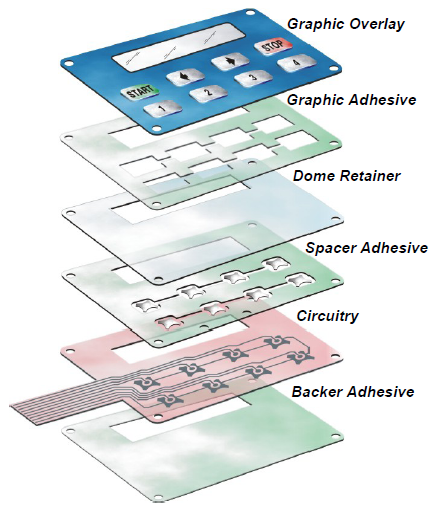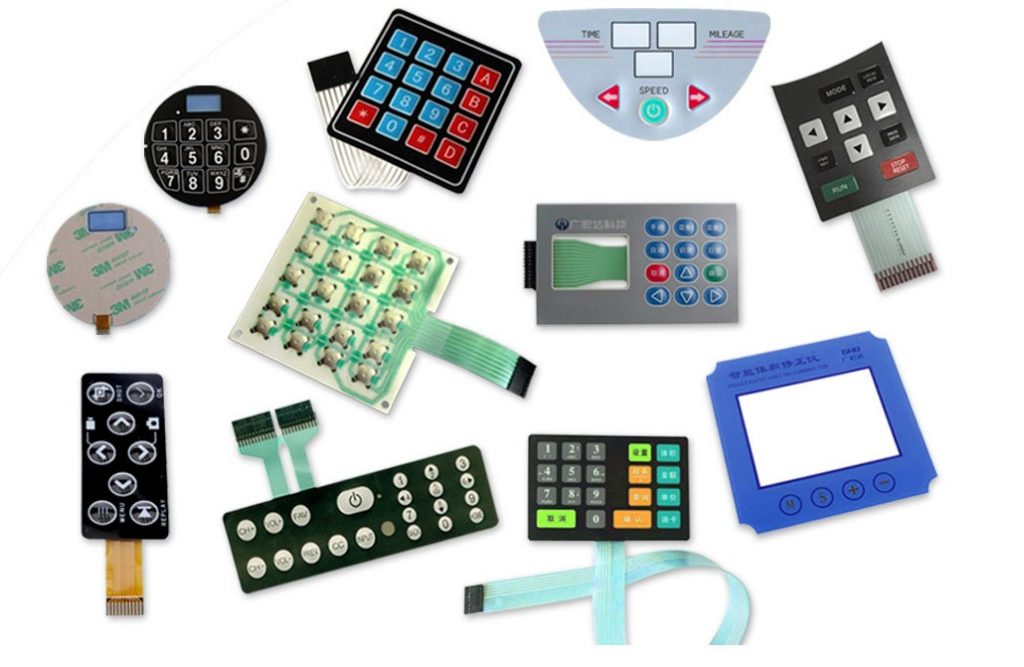The Manufacturing Refine Behind Membrane Switch Over: What You Required to Know
The manufacturing procedure behind membrane switches over combines cautious layout, material option, and high quality control. It starts with comprehending the details of membrane button design and proceeds through different phases, including product choices and printing strategies. Each phase plays a crucial function in making certain performance and longevity. The intricacies of layer construction and the strenuous screening standards might disclose understandings that are not instantly evident. What exists beyond these foundational aspects?
Recognizing Membrane Layer Switch Style
Although membrane layer switches might show up simple initially look, their layout entails intricate considerations that ensure capability and durability. The style process begins with a complete understanding of customer needs, consisting of the user interface's desired application and ecological aspects. Comfort designs is a key component, as the format has to help with simplicity of use while ensuring that responsive comments fulfills individual expectations.Moreover, the layering of components, such as visuals overlays, glue layers, and conductive traces, must be precisely engineered. membrane switch. This split arrangement not only affects the button's responsiveness yet likewise affects its longevity. Interest is offered to the sealing techniques used to secure against moisture and dirt, which might jeopardize performance. In addition, style considerations include aesthetics, where shade plans and visual quality improve user experience. Ultimately, the style of membrane switches over balances functionality, customer experience, and sturdiness, guaranteeing that they fulfill the demands of various applications properly
Materials Made Use Of in Membrane Switch Production
When selecting products for membrane switch production, it is important to contemplate both efficiency and sturdiness. The key materials consist of polyester and polycarbonate films, which give versatility and toughness. These films are usually coated with sticky to guarantee appropriate bonding to substrates. Conductive inks, typically composed of silver or carbon, are critical for producing electric connections within the switch, permitting reputable operation.Additionally, a safety layer, such as a hard layer, is regularly applied to improve scratch resistance and durability. The selection of backing material, such as acrylic or foam, can considerably affect the button's tactile feel and general customer experience. Different environmental aspects, consisting of temperature level and humidity, should direct product choice to assure peak efficiency in details applications. Ultimately, the best combination of materials contributes to the membrane switch's capability and life expectancy, making educated selections essential for producers.
The Printing Process: Creating Graphics and Text
The printing process in membrane switch manufacturing plays a significant role in producing top quality graphics and text. Various visuals style techniques are employed to guarantee aesthetic allure and capability, while mindful ink option techniques are necessary for toughness and efficiency. Comprehending these aspects is fundamental for achieving ideal lead to membrane layer switch design.
Graphic Layout Techniques
Graphic style techniques play an important duty in the printing procedure of membrane buttons, as they define how graphics and message will eventually show up on the end product. Efficient graphic layout includes the strategic use fonts, colors, and layouts to improve readability and aesthetic appeal. Developers typically utilize vector graphics for scalability, ensuring that pictures remain sharp at different dimensions. Furthermore, attention to comparison and alignment is essential, as it influences customer interaction and aesthetic top quality. The consolidation of branding components, such as logos, must be managed with like keep brand name integrity. On the whole, thoughtful graphic design techniques contribute substantially to the functionality and beauty of membrane layer switches, affecting individual experience and item performance.
Ink Selection Techniques
Picking the appropriate ink is vital for attaining the wanted aesthetic quality and toughness in membrane layer switch production. Different ink types are used, consisting of solvent-based, water-based, and UV-curable inks. Each kind offers distinct qualities, such as attachment, resistance, and adaptability to ecological aspects. Solvent-based inks are often preferred for their sturdiness and vivid shades, while water-based inks are a lot more environmentally pleasant but may have constraints in bond. UV-curable inks provide rapid treating and robust performance. Additionally, color matching strategies assure that the picked inks line up with style specs. Ultimately, the choice of ink have to take into consideration variables such as application technique, substrate compatibility, and end-use requirements to achieve premium lead to membrane switch graphics and message.
Layer Building And Construction and Setting Up

Product Choice Refine
A mindful option of products is essential in the manufacturing process of membrane switches, as it directly influences functionality and resilience. The main materials utilized include polyester, polycarbonate, and different conductive inks. Polyester is commonly preferred for its exceptional resistance to chemicals and abrasion, making it ideal for extreme atmospheres. Polycarbonate, on the various other hand, supplies remarkable quality and influence resistance, which is valuable for applications calling for exposure and toughness. Conductive inks, normally composed of silver or carbon, are important for creating dependable electrical paths. In addition, the option of sticky materials impacts the overall integrity of the button - membrane switch. Reviewing factors such as environmental direct exposure, tactile feedback, and visual demands guides manufacturers in picking the finest materials for their specific applications
Layer Attachment Methods
Adhering layers in membrane layer switch construction is an essential process that guarantees capability and durability. Various bond techniques are used to protect ideal bonding in between layers, which usually include the usage of adhesives, heat, and stress. Pressure-sensitive adhesives (PSAs) are typically made use of for their simplicity of application and prompt bonding abilities. Additionally, thermal bonding methods can be applied, where warm is used to trigger glue residential properties, securing a solid bond. The choice of attachment approach mainly depends on the materials entailed and the particular application needs of the membrane switch. Correct alignment and uniform application of adhesives are essential to stop issues, securing the button runs effectively throughout its designated life-span.
Quality Assurance Procedures
Assuring quality control during the layer building and setting up of membrane switches is vital for keeping efficiency and reliability. This process normally entails several vital procedures, consisting of thorough evaluations at each stage of manufacturing. Makers make use of innovative testing methods, such as peel tests and adhesion assessments, to confirm the stability of layer bonds. Furthermore, aesthetic examinations are performed to recognize any kind of defects in printing or material inconsistencies. Environmental conditions, such as temperature and humidity, are carefully kept track of to guarantee perfect curing and adhesion. Routine calibration of devices helps maintain specific production criteria. By applying these top quality control procedures, makers can considerably decrease the risk of item failing, ensuring that the final membrane layer changes satisfy the required requirements and consumer assumptions.
Evaluating and Quality Assurance Actions

Advancements in Membrane Switch Over Modern Technology
As innovations in innovation continue to advance, membrane layer switches are gaining from ingenious developments that improve their functionality and customer experience. One noteworthy innovation is the assimilation of capacitive touch technology, which enables more receptive and user-friendly customer interfaces. This shift not just improves aesthetics however also minimizes mechanical wear and tear, prolonging the life-span of the switches.Additionally, developments in visuals overlay materials have actually led to enhanced longevity and resistance to environmental aspects such as moisture and UV light. These materials currently offer improved quality and brightness, additional boosting the aesthetic appeal.Furthermore, the incorporation of clever modern technology is transforming membrane switches over right into interactive control panels, allowing connection with IoT tools. This connectivity promotes a smooth customer experience, leading the way for applications in different sectors, from medical care to consumer electronics. Collectively, these advancements placement membrane layer switches as vital elements in modern-day tool design.
Frequently Asked Questions
For how long Does the Membrane Layer Switch Over Production Process Take?
The duration of the membrane switch manufacturing process can vary considerably. Elements such as complexity, materials utilized, and manufacturing quantity impact timelines, with regular manufacturing varying from a couple of days to numerous weeks for completion.
What Are the Common Applications for Membrane Buttons?
Membrane layer buttons are generally made use of in numerous sectors, consisting of vehicle controls, house devices, clinical gadgets, and consumer electronics (membrane switch). Their adaptability and longevity make them ideal for applications requiring user-friendly interfaces and dependable performance in diverse atmospheres
Can Membrane Switches Be Customized for Specific Demands?

What Is the Lifespan of a Common Membrane Change?
The life-span of a typical membrane switch varies, but typically, it ranges from 1 to 5 million cycles. Elements such as usage, atmosphere, and worldly top quality substantially affect durability and overall performance in time.

Are Membrane Layer Switches Over Ecologically Friendly?
The environmental friendliness of membrane layer switches over differs. Some materials used might not be recyclable, while others can be green. The total influence depends upon producing products and methods, demanding cautious consideration throughout option and disposal. The production process behind membrane layer changes combines cautious design, product choice, and high quality control. It begins with recognizing the ins and outs of membrane button style and progresses through numerous stages, consisting of material choices and printing strategies. When selecting products for membrane button manufacturing, it is important to ponder both performance and durability. A mindful selection of products is vital in the production process of membrane layer switches, as it straight influences capability and sturdiness. The selection of bond approach mostly depends on the products included and the details application requirements of the membrane layer switch.